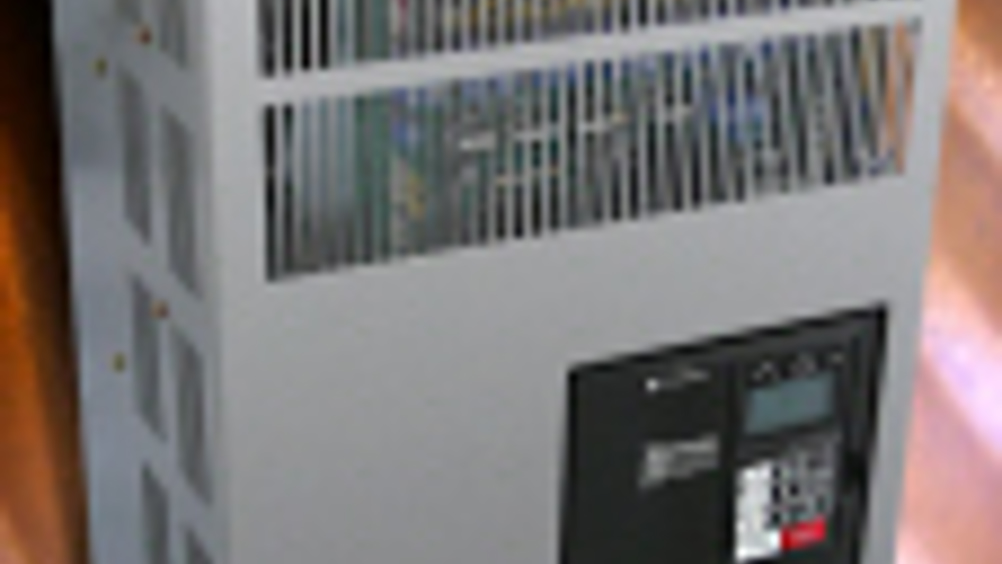Matrix converter offers improved energy efficiency and longer life
The global technology race to develop the world's first matrix converter for variable speed drives has been won by a Japanese company. Dean Palmer reports

Minimal generation of harmonics, regenerative braking without the need for additional resistors, enhanced operating life and the automatic return of energy to the supply during braking, are just some of the benefits now being promised by Yaskawa Electric's new matrix converter technology for variable speed drives (VSDs).
The Japanese company claims it has won the global technology race to unveil the world's first variable speed AC motor control to use matrix converter technology and said it expects the new drives to be ready by the middle of July this year. The drives will initially be supplied in three-phase, 400V versions with ratings from 5.5kW up to 22kW. This range will be expanded later up to 75kW and 200V models with ratings from 5.5kW to 45kW also available.
The actual breakthrough comes in the design of the bi-directional switches and combinations of switches that need to be fast enough (nanosecond response times) to cope with the requirements of the motor. The software that programmes the switches is also an area where Yaskawa has made crucial breakthroughs.
How to develop a practical working model for matrix converters has puzzled academics, research establishments and variable speed drive manufacturers for more than a decade, but Yaskawa has made a breakthrough. The theory behind matrix converters has been known for many years, but it is only recently that developments in fast, fourth generation insulated gate bipolar transistors (IGBTs) and advanced digital processors have enabled its practical implementation.
So how do matrix converters benefit variable speed drives? According to Stephen King, UK technical manager at Yaskawa, the firm's new matrix converter drives will offer efficient operation in all four quadrants of torque/speed plane due to their regeneration capability. He explained: "The input current waveform is sinusoidal and the input power factor is almost unity. This means little energy is wasted and you get high dynamic drive performance and high impact load resistance. Another benefit is high reliability and long life due to the absence of electrolytic capacitors, and there is continuous zero speed operation because there is no current concentration in any of the switches. EMC filters and harmonic filter components are also not required."
Traditional VSDs convert the incoming AC supply to DC, then convert the DC back to AC at the required frequency and voltage. Yaskawa's matrix converter drives use an array of semiconductor switches - packaged IGBTs - to connect the three phases of the supply directly to the motor in a precisely timed sequence.
This method of operation reduces harmonic generation to around 8% of the level associated with conventional drives and also offers almost unity power factor, in other words, no wasted energy. By eliminating the DC bridge section of the drive, Yaskawa has made it easy to arrange for energy to be returned to the supply during braking and also removes the need for energy-wasting, heat-generating braking resistors.
The matrix converter itself is a direct power conversion device that converts three-phase AC line voltages to variable frequency three-phase outputs. Each switch consists of two IGBTs with diodes. The nine switches are bi-directional, the switching pattern being established via a pulse width modulator (PWM) technique. Voltage control is achieved by the appropriate selection of groups of bi-directional switches.
The matrix static frequency changer directs the output voltage for all three phases to the motor, absorbing current disturbances and delivering a 'clean' output voltage. Yaskawa's design also uses input displacement angle control so the power factor can be made unity. This gives excellent drive power quality and a high kW/volume rating. As King explained: "Compared to a conventional diode-rectifier front end type PWM inverter drive, the input current harmonics distortion remains low [below 10%] under all operating conditions."
Another crucial benefit of the new drive is that it doesn't require large electrolytic capacitors. Since the unavoidable deterioration of these capacitors is the principle life-limiting factor in most modern electronic equipment, eliminating them serves to further boost the drive's reliability and operating life.
The matrix converter's high resistance to impact loads is excellent and prototype versions have demonstrated less than 1.5% rated speed drop (or overshoot) for a 50% step load torque change.
The matrix converter provides high efficiency and very fast energy transfer to the supply, making it ideal for applications with large inertia that require frequent and fast deceleration without the need for braking resistors. Even though the price of the drives could be 50 to 100% higher than conventional VSDs, Yaskawa suggested that this should not prevent manufacturers of cranes, elevators, eccentric drives, presses and cutting machines, drive test benches and centrifuges from investing in the technology.
And, because the matrix converter offers low harmonic distortion levels and typically alleviates the need for extra filters and inductors, the drives could find themselves in stand alone applications where industrial equipment is combined in a general purpose environment or on ships and office environments where the power supply is limited. Hospitals and IT centres should also be interested in the new, low harmonics drives. King concluded: "Due to its superior energy efficiency, power quality and smaller physical size, the matrix converter is the strongest electronic variable speed drive candidate to meet the stringent 'Clean Environment' requirements of the modern world."









